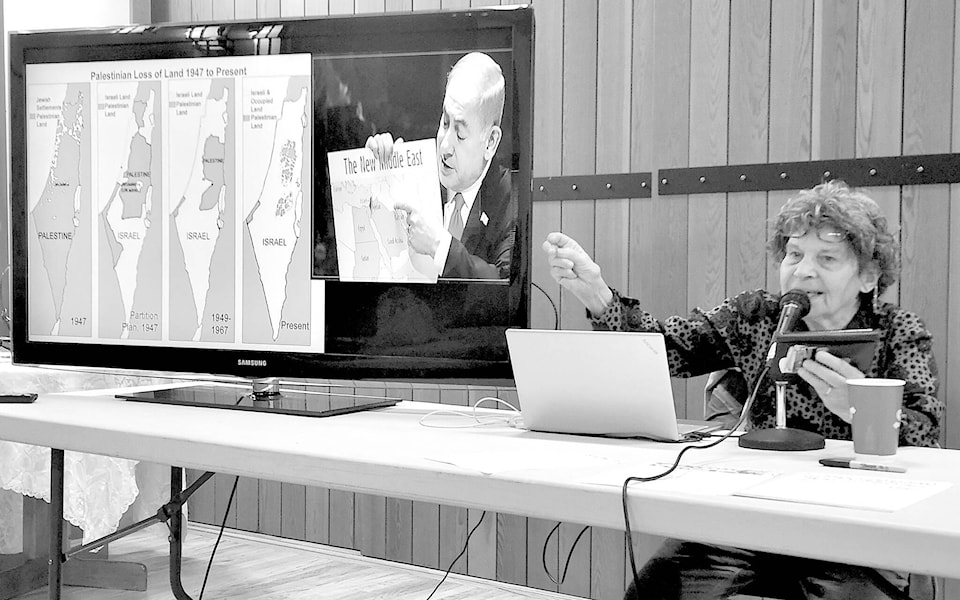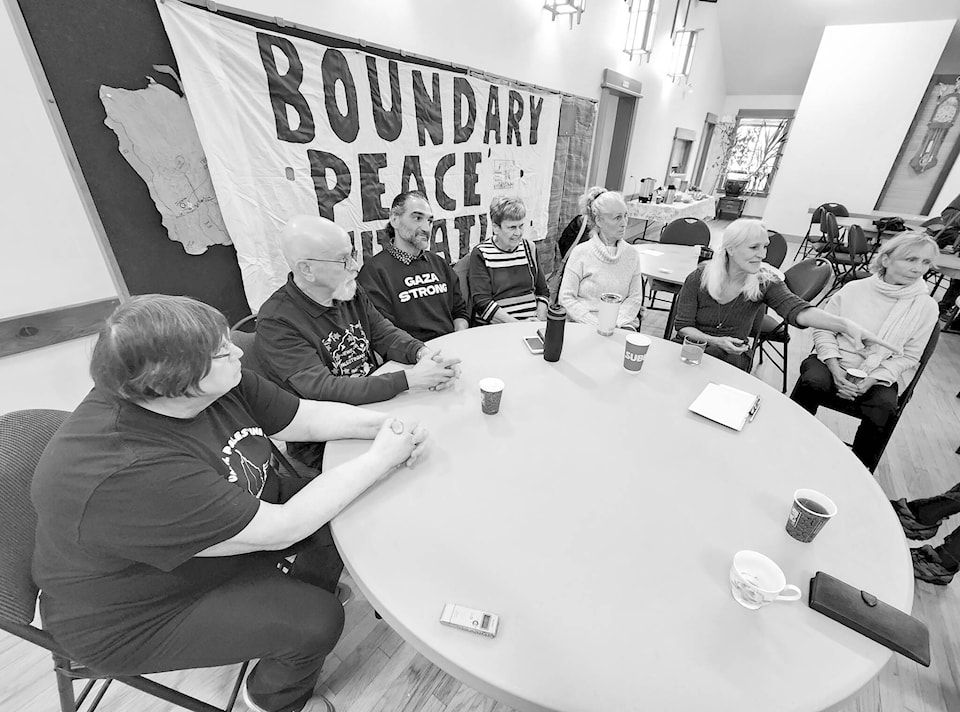Elected officials and local Grand Forks-area residents spent Saturday at the Holy Trinity Anglican Church to hear from those with lived experiences and experts on the ongoing Israel-Palestine conflict.
The Boundary Peace Initiative hosted the Hope for Palestine conference on March 23, which drew audience members such as Mayor Everett Baker, Councillor Christine Thompson and RDKB Area D Director Linda Kay Wiese.
Around 50 people showed up for the event to hear panelists, which included: Jewish/Quaker activist and author Maxine Kaufman-Lacusta, Jewish labour activist Sid Sniad, Canadian Boat to Gaza and Freedom Flotilla representative Susan Ghattas and Adam Othman Hamdan, a Muslim Palestinian currently living in Christina Lake.
Topics for the day focused on antisemitism, zionism, extremism, political history and even war crimes – but the collective goal for the event was to hear discussion on how people can help seek peace while so far away from the conflict, said moderator Laura Savinkoff.
Saturday marked roughly 170 days of Israel’s war on Gaza, following the Oct. 7 attack by Hamas miliants at an outdoor music festival, which killed 1,200 people killed and around 240 taken hostage. Among the casualties were Isreali soldiers, civilians and foreigners. Since then, it is estimated that more than 30,000 Palestinians have been killed with about half of those children.
A report from Coordination of Humanitarian Affairs cited social security data that showed that of the total death toll, 695 of those killed were Israeli civilians. The others were security forces and foreigners. There are also reports of Israeli civilians being killed by friendly fire on Oct.7, including a house in Kibbutz Be’eri getting shelled by a tank, leaving 12 Israelis dead
“Oct. 7 wasn’t the beginning,” Savinkoff said, adding that the panelists include independent Jewish voices and all bringing forward their own individual lived experiences. The Boundary Peace Initiative has been working with partners since 2002 to help raise awareness over the ongoing conflict and initiatives to help bring about peace.
“Now we feel we could have a direct voice in this issue because people are finally willing to listen,” Savinkoff said.
For much of the conference, an image of a map of Israeli and Palestinian lands was projected on a TV screen, detailing the shrinking Palestinian land since 1947, when Israel gained some territory under the United Nations’ Partition Resolution.
Experiences shared by the panelists
As the lone Palestinian, Hamdan said the attendance and discussion left him with hope that some kind of solution is possible, even after decades of fighting.
“This was very encouraging because Grand Forks is far removed from Palestine…,” he said, noting South Africa’s efforts to bring forward the actions being seen in the war to the International Criminal Court.
“It seems that there are people here in Canada from all walks of life that are willing to fight the good fight (in the audience and on the panel),” he said. “It was encouraging to see that many people and we will continue forward with more actions.”
There were also break-out talks among the audience, panel speakers and a post-panel brainstorming session on next steps for local supporters.
Panelist Kaufman-Lacusta encouraged attendees to read and research non-violent protest and information sharing strategies. Much of her research since 1988 has focused on peaceful activism – largely led by young people – as she lived between Canada and Jerusalem. Her work includes editing essay collections, such as Peace Under Fire.
“I was impressed with the wide variety of the resistance to the occupation that I witnessed or read about while working there,” she said.
She highlighted when she returned to Israel to work on the book Refusing to be Enemies, she saw that years of work by protesters were still moving forward.
“During the research and interviews, I could see the long tradition of Palestinian non-violent resistance, so many of which I had witnessed when I was in Jerusalem for the first Intafada, had continued,” she said. “Support from Israelis and internationals, both in-person and long-distance was both helpful and appreciated in increasing the safety of the participants.”
A lot of activism has been supported by international partners, on land and sea. Ghattas, speaking on behalf of the Freedom Flotillas, shared with attendees that early successes in getting aid to Gaza through the Mediterranean Sea blockades.
Many of those efforts were led by women, she added.
“There’s been a lot of female-led activism, which led to the continuation of the mission in two parts, which we had one in 2023 circumventing the coast of Europe to raise awareness and work with boat people on the ground,” she said.
“The other is a direct link that is heading to the Mediterranean,” she said. “We are releasing the boats to go as far as we can towards Gaza.”
Another flotilla in partnership with the Save Gaza initiative is planned for later in the spring.
A flotilla is several boats sailing together in formation, often for a specific purpose.
While Ghattas won’t be in the flotilla this year, she is expecting the same challenges with the ongoing blockades around the region.
The reason for this flotilla is to raise awareness and show the world what activists have to endure to get aid to people in need, plus raise as many funds as they can.
“We are trying to help as many of our partners as we can,” Ghattas said. “Our volunteers aren’t on the boats as much anymore, they are on the ground helping when the boats pull into port. It’s about raising political awareness in terms of a massive grassroots appeal.”
Meanwhile, Sniad’s talk to attendees focused on the geography of the conflict and the decades of land once owned by Palestinian people claimed by Israeli settlement initiatives.
“There are many things we have to unlearn, and one of the fundamental things is zionism,” he said. “Someone mentioned that this is a conflict going back 3,400 years, and that is not true. Christian, Muslims and Jews lived in harmony in the Middle East until the onset of zionism political doctrine that is less than 150 years old.”
The decades-long conflict won’t be solved by one person in a short time frame, he said. It’s going to take a coordinated effort by the world, which includes the South African government charging citizens that go to fight in Israeli forces, the country calling for an investigation by the International Court for war crimes by Israel, as well as the Canadian federal government recently voting to stop selling arms to Israel.
It has been done elsewhere, he said, citing Ireland and its government ending decades of fighting between Protestants and Catholics through political means.
He also urged attendees to start asking questions about corporations and government agencies that fund Israeli military initiatives. MP Richard Cannings, who was in the audience, said he would be looking into supposed tax write-offs people and organizations are allegedly eligible to receive if funding gives support to Israeli government settlement initiatives.
During the post-panel brainstorming session, discussion focused on what more can be done in the Grand Forks and Boundary Creek region.
Councillor Thompson said she’s ready to put forth a motion that the city call for an immediate and permanent ceasefire, going so far to note that her fellow officials would support it.
She added she was sure there would be some negative comments and there is a possibility it could fail, but if were to not pass, she suggested a delegation come to the April 15 meeting to voice their disappointment and push for another ceasefire call.

